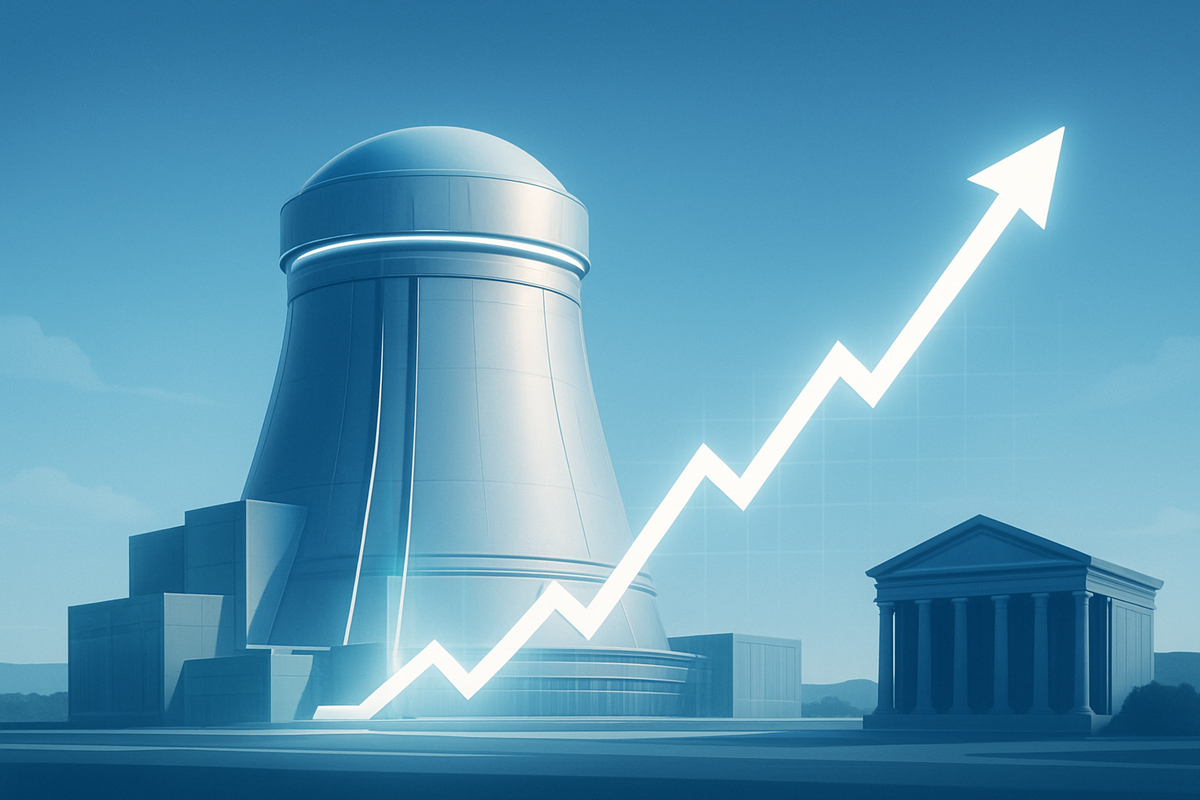
As the United States stands on the cusp of a potential nuclear energy renaissance, all eyes are turning to the upcoming earnings reports of key domestic players. Among them, BWX Technologies, Inc. (NYSE: BWXT), a long-standing pillar of the nation's nuclear defense and energy infrastructure, finds itself in the spotlight. With former President Donald Trump actively championing a robust expansion of the nuclear sector through a series of executive orders and strategic partnerships, BWXT's financial performance is anticipated to offer a critical barometer of the industry's burgeoning momentum and the tangible impact of renewed political will.
The confluence of anticipated earnings and decisive governmental backing sets a compelling stage for investors and industry observers alike. The market is keenly awaiting insights into how recent multi-billion-dollar contracts and a significantly more favorable regulatory environment translate into the company's bottom line. This moment represents more than just a quarterly financial update; it's a litmus test for the viability and acceleration of the U.S. nuclear industrial base, particularly as the nation seeks to secure energy independence, power advanced technologies like AI, and reassert its leadership in nuclear innovation.
A New Dawn for Nuclear: Trump's Strategic Push and BWXT's Expanding Role
The narrative of America's nuclear resurgence has been significantly shaped by the proactive stance of former President Donald Trump. In May 2025, Trump signed a series of four executive orders designed to modernize nuclear regulation, streamline reactor testing, and strengthen the domestic nuclear industrial base, with ambitious targets including quadrupling U.S. nuclear capacity by 2050 and deploying 10 new large reactors by 2030. These directives underscore a clear intent to cut bureaucratic red tape and accelerate deployment, creating an unprecedentedly supportive environment for companies operating in the sector.
Further solidifying this commitment, October 2025 saw a landmark strategic partnership announced involving the U.S. government, Westinghouse Electric Company, Brookfield Asset Management, and Cameco Corporation. This colossal $80 billion program is earmarked for constructing new nuclear reactors across the United States utilizing Westinghouse technology, specifically aimed at meeting the nation's escalating electricity demands, including those from burgeoning AI data centers. This partnership not only injects massive capital into the industry but also signals a concerted effort to rebuild and expand the domestic nuclear supply chain.
Against this backdrop, BWX Technologies (NYSE: BWXT) has emerged as a primary beneficiary, securing substantial government contracts that reflect its critical role in both defense and commercial nuclear applications. In September 2025, BWXT was awarded a significant $1.5 billion contract by the Department of Energy's (DOE) National Nuclear Security Administration (NNSA) to establish a domestic uranium enrichment capability crucial for defense purposes. This followed a robust July 2025, where the company secured over $2.6 billion in contracts for naval nuclear reactor components, cementing its indispensable position in national security. These recent awards, coupled with earlier DOE contracts in October 2024 for advanced reactor fuel production, highlight BWXT's deep integration into the government's nuclear strategy and position its anticipated earnings report as a key indicator of the financial fruits of these policies.
Winners and Losers: A Shifting Landscape for Nuclear Innovators and Utilities
The invigorated political and financial support for nuclear energy is redrawing the lines of competition and opportunity within the industry, creating clear winners and potential challenges for others. At the forefront of the beneficiaries are specialized nuclear technology providers and fuel cycle companies. BWX Technologies, Inc. (NYSE: BWXT), as detailed, stands to gain immensely from its direct involvement in government contracts for naval propulsion and now, domestic uranium enrichment for defense. Its upcoming earnings are expected to reflect the significant revenue streams from these long-term, high-value contracts, signaling robust growth and stability.
Another significant winner is Centrus Energy Corp. (NYSE American: LEU), which holds the unique distinction as the only U.S. Nuclear Regulatory Commission (NRC)-licensed producer of High-Assay, Low-Enriched Uranium (HALEU). HALEU is a critical fuel for advanced reactors, and Trump's executive orders to expand domestic uranium enrichment and create a HALEU fuel bank directly benefit Centrus. The company has already secured multiple DOE awards, with potential contracts reaching up to $3.4 billion over ten years, positioning it as a cornerstone of the future nuclear fuel supply chain. Its earnings, when reported, will likely reflect the accelerating demand and strategic importance of its offerings.
Beyond these specialized players, the broader utility sector, particularly those operating existing nuclear power plants, also stands to benefit. Companies like Constellation Energy (NASDAQ: CEG) and Public Service Enterprise Group (NYSE: PEG), which manage extensive nuclear fleets, will likely see increased stability and potentially favorable market conditions for their assets due to a pro-nuclear policy environment. This support can manifest in streamlined regulatory processes, extended operating licenses, and a more predictable revenue stream for their carbon-free baseload power. Conversely, companies heavily invested in other energy sources that might be disfavored, or those unable to adapt to the accelerating pace of nuclear innovation and deployment, could face increased competitive pressure in the long term, though direct "losers" are less immediately apparent given the overarching energy demand.
The Broader Implications: Energy Security, Geopolitics, and AI's Hunger for Power
The resurgence of the U.S. nuclear industry, heavily influenced by political directives, carries far-reaching implications that extend beyond corporate balance sheets. This movement is fundamentally reshaping broader industry trends, signaling a significant pivot in national energy strategy. After decades of stagnation, nuclear energy is now being positioned as a critical solution for energy independence, climate goals, and the insatiable power demands of emerging technologies like Artificial Intelligence. The push for Small Modular Reactors (SMRs) and advanced reactor designs, supported by government funding and streamlined licensing, indicates a shift towards more flexible, scalable, and safer nuclear power generation.
The regulatory and policy implications are profound. Trump's executive orders aim to dismantle bureaucratic hurdles that have historically slowed nuclear development, promising faster licensing and construction timelines. This creates a more predictable and attractive investment climate, potentially unlocking billions in private capital. Furthermore, the emphasis on strengthening the domestic nuclear fuel cycle, including uranium enrichment and HALEU production, has significant geopolitical ramifications. By reducing reliance on foreign sources, particularly from Russia, the U.S. aims to bolster its energy security and wield greater influence in global energy markets. This strategic independence is crucial in an era of heightened international tensions.
Historically, the U.S. nuclear industry has experienced cycles of boom and bust, often tied to political will and public perception. The current push draws comparisons to the 1970s and 80s when a wave of nuclear plant construction occurred, albeit eventually slowed by safety concerns and economic factors. However, today's landscape is different, with advanced reactor designs, enhanced safety protocols, and a pressing need for carbon-free baseload power. The integration of nuclear power into the national security framework, as evidenced by its role in powering Department of Defense facilities and its potential for space exploration, also marks a new dimension to its strategic importance, distinguishing this era from previous cycles. The drive to power AI data centers with nuclear energy is a novel and powerful catalyst, aligning the industry with the cutting edge of technological advancement.
The Path Forward: Strategic Pivots and Emerging Opportunities
Looking ahead, the landscape for the nuclear industry, particularly for companies like BWX Technologies, is poised for significant evolution. In the short-term, the focus will remain on the execution of existing contracts and the realization of efficiencies from the streamlined regulatory environment. Companies will need to demonstrate their capacity to scale up production, manage complex supply chains, and meet the aggressive timelines set forth by governmental initiatives. BWXT's ability to consistently deliver on its defense and fuel cycle commitments will be crucial in reinforcing investor confidence and securing future awards. The market will be watching closely for how effectively these players can translate policy support into tangible operational growth and profitability.
For the long-term, the industry faces both immense opportunities and strategic challenges. The push for a domestic nuclear fuel cycle and the deployment of advanced reactors will necessitate substantial investment in infrastructure, workforce development, and technological innovation. Companies will need to make potential strategic pivots or adaptations, potentially forming new partnerships, investing in R&D for next-generation technologies, or expanding into new markets such as small modular reactor (SMR) components or even microreactors for remote applications and military bases. The evolving energy demands of AI data centers present a burgeoning market opportunity, pushing nuclear developers to innovate in terms of reactor size, deployment speed, and grid integration.
Potential scenarios and outcomes include a rapid acceleration of new reactor construction, leading to a significant increase in the U.S. nuclear energy output and a reduction in carbon emissions. Conversely, unforeseen challenges in supply chain, regulatory hurdles, or public acceptance could slow progress, though the current political tailwinds appear strong. Investors should anticipate a period of sustained growth for well-positioned companies, but also be mindful of the capital-intensive nature of nuclear projects and the need for consistent governmental support. The next few years will be critical in determining whether this nuclear renaissance becomes a lasting transformation of the U.S. energy landscape.
A New Era of Nuclear: Assessing Impact and Investor Outlook
The anticipated earnings report from BWX Technologies (NYSE: BWXT), set against the backdrop of former President Trump's fervent support for the nuclear industry, marks a pivotal moment for the sector. The key takeaway is clear: the U.S. government is unequivocally committed to revitalizing its nuclear capabilities, driven by imperatives of energy security, economic competitiveness, and the pressing demand for clean, reliable power, particularly for the burgeoning AI sector. This policy shift has translated into substantial, multi-billion-dollar contracts for key players like BWXT and Centrus Energy Corp. (NYSE American: LEU), signaling a period of robust growth and strategic importance for these companies.
Assessing the market moving forward, the outlook for the nuclear industry appears significantly brighter than in previous decades. The combination of strong political backing, a push for regulatory streamlining, and the strategic recognition of nuclear power's role in national defense and advanced technology offers a compelling growth narrative. While the nuclear sector has historically been characterized by long development cycles and high capital costs, the current environment aims to mitigate these challenges through direct government investment, loan guarantees, and accelerated approval processes. This creates a more predictable and attractive investment climate, drawing renewed interest from institutional and retail investors alike.
Final thoughts on significance and lasting impact underscore that this isn't merely a cyclical upturn but potentially a fundamental reorientation of U.S. energy policy. The emphasis on domestic production, from uranium enrichment to reactor manufacturing, has profound implications for national security and economic resilience. This nuclear renaissance could solidify America's position as a global leader in advanced nuclear technology, influencing international energy markets and diplomatic relations.
What investors should watch for in the coming months includes not only the financial performance of companies like BWXT and Centrus but also the progress of major projects, particularly the $80 billion Westinghouse partnership. Key indicators will be the speed of regulatory approvals for new reactors, the establishment of the HALEU fuel bank, and any further legislative actions designed to support the industry. Investors should also monitor the broader macroeconomic environment and energy demand trends, as these will continue to shape the long-term trajectory of the nuclear sector. The journey ahead promises to be dynamic, with significant opportunities for those positioned to capitalize on this renewed era of nuclear power.
This content is intended for informational purposes only and is not financial advice




